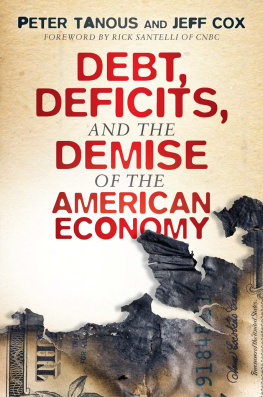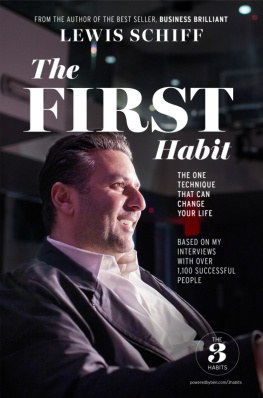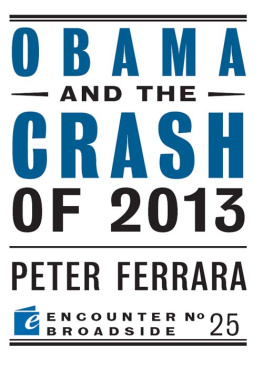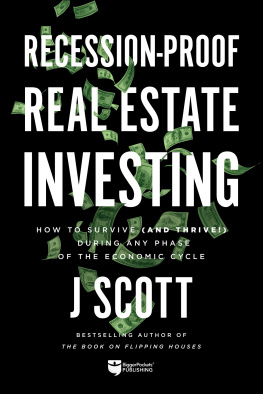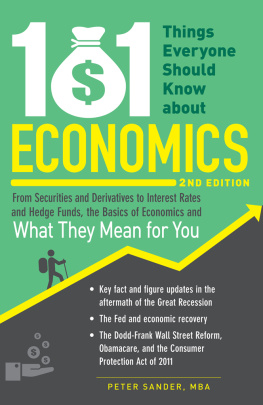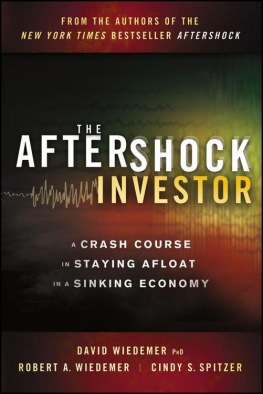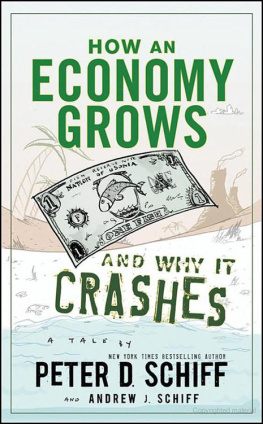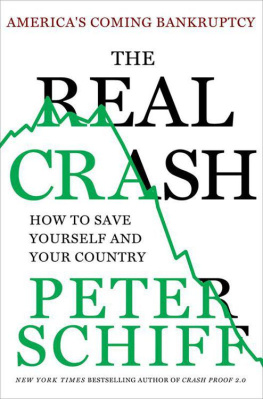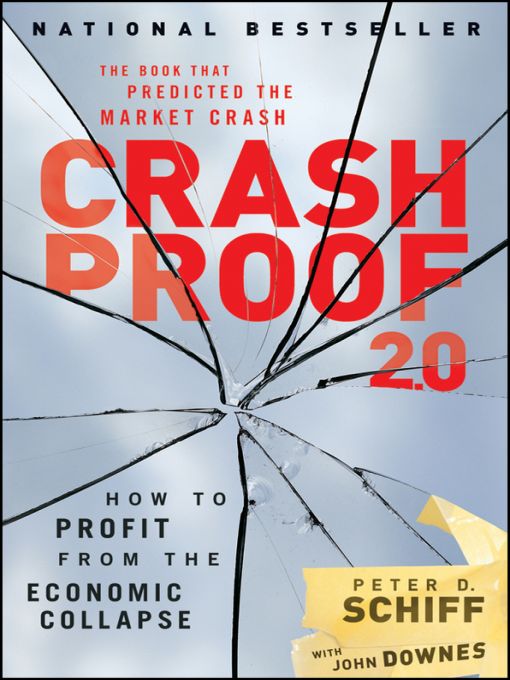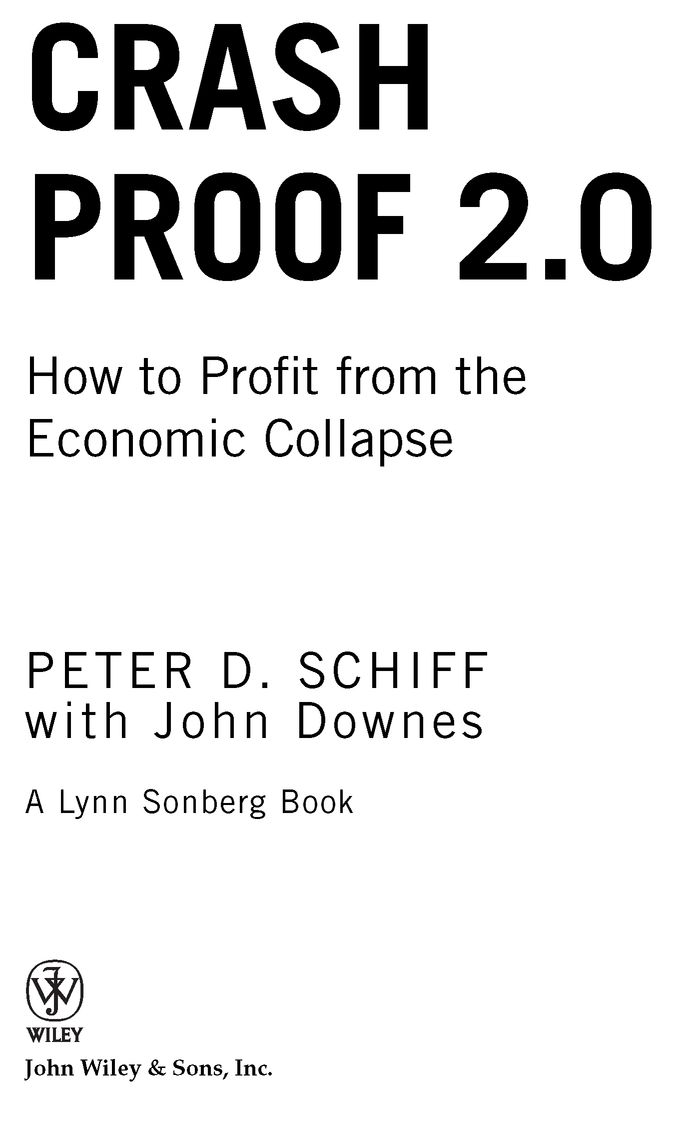Table of Contents
To my father, Irwin Schiff, whose influence and guidance concerning basic economic principles enabled me to see clearly what others could not; to my son Spencer, in whom I hope to instill a similar vision; and to his and future generations of Americans, who through hard work and sacrifice might one day restore this nation to her former glory
Disclaimer
Disclosure
Data from various sources was used in the preparation of this book. The information is believed to be reliable, accurate and appropriate but it is not guaranteed in any way. The forecasts and strategies contained herein are statements of opinion, and therefore may prove to be inaccurate. They are in fact the authors own opinions, and payment was not received in any form that influenced his opinions. Peter Schiff and the employees of Euro Pacific Capital implement many of the strategies described. This book contains the names of some companies used as examples of the strategies described, as well as a mutual fund that can be sold only by prospectus; but none can be deemed recommendations to the books readers. These strategies will be inappropriate for some investors, and we urge you to speak with a financial professional and carefully review any pertinent disclosures before implementing any investment strategy.
In addition to being the President, Peter Schiff is also a registered representative and owner of Euro Pacific Capital, Inc (Euro Pacific). Euro Pacific is a FINRA registered Broker-Dealer and a member of the SIPC. This book has been prepared solely for informational purposes, and it is not an offer to buy or sell, or a solicitation to buy or sell, any security or instrument, or to participate in any particular trading strategy. Investment strategies described in this book may ultimately lose value even if the opinions and forecasts presented prove to be accurate. All investments involve varying amounts of risk, and their values will fluctuate. Investments may increase or decrease in value, and investors may lose money.
Authors Note,Crash Proof 2.0
In 2005 when I first proposed a book forecasting a collapse of the American economy, it was difficult finding a publisher willing to consider the project. After all, at that time the very idea seemed utterly preposterous; the economy was generally viewed as healthy, prosperous, and growing, and John Wiley & Sons was the only company willing to take a chance. I finished writing the book by mid-2006, and the first copies arrived in bookstores in February 2007. Yet even then, as warning bells began to sound, most would have considered a book about an imminent collapse of the American economy to be science fiction. More than two years later, in mid-2009, the business and investment shelves of bookstores were filled with new releases analyzing the calamities of the previous two years and offering various theories about the future. With all due respect to my fellow authors, however, most of them were writing after the fact and starting from the premise that the present crisis could not have been predicted.
More important, while most believe that the economic collapse is over, the reality is that it has only just begun. What we have witnessed thus far are merely the events that have set the collapse in motion. It will take some time for all the dominoes to fall. But fall they will, perhaps even more spectacularly now than how I initially envisioned back in 2005.
With respect to the format of Crash Proof 2.0, I decided it made sense to keep the original Crash Proof text unchanged and add updated commentary at the end of each chapter. My reasoning had partly to do with the time-honored rule of not messing with a winning formula. I have received voluminous feedback from readers who praise it as a uniquely easy-to-understand treatment of a complex and intimidating subject.
My other reason was that it lays out the basic economic way of thinking that underlies my accurate predictions. Anyone can be a Monday-morning quarterback. Its another thing to call the plays Sunday afternoon. Leaving the original text intact enables you to see that our problems today are the consequences of pernicious fundamental trends that I have recognized and warned about for years. It clearly separates me from the perma-bears, chronic pessimists whose predictions, like a stopped clock, are automatically accurate at least some of the time. Nor, with my global view, can I even be called a bear. As the U.S. economy has steadily deteriorated, I have been very bullish on investments that have done extraordinarily well. I have equal confidence in my current predictions.
The Preface and Introduction remain unchanged as integral parts of the original Crash Proof. If you are new to Crash Proof, you should read Crash Proof 2.0 cover to cover. Previous readers will focus on the 2009 updates and use the original chapters as a handy reference.
Given how accurate the forecasts I made in Crash Proof turned out to be, Crash Proof 2.0 should be that much more compelling a read. If some of my predictions still seem improbable, just remember how improbable those that already came true looked when I originally made them.
IMPORTANT FINAL THOUGHTS BEFORE GOING TO PRESS
During the late spring of 2009, as I was completing the revisions you are about to read, well-established primary bear market trends in the U.S. dollar and bull market trends in foreign stocks, gold, and other commodities were still in a temporary reversal phase. In mid-2008, investors around the world had reacted to a collapsing American financial system by doing an about-face. Like horses running back into a burning barn, they dumped commodities and foreign stocks and poured funds into U.S. dollars and U.S. Treasury securities. Now, just as suddenly, there is a mad scramble to reverse those trades, and the primary trends have resumed.
What happened in 2008 was the result of several factors: A credit crunch that amounted to a global margin call caused forced, massive selling of gold and other viable assets that had high liquidity; our trading partners were instinctively inclined to prop up their best customer and continued buying American debt, regardless of its diminishing creditworthiness; and the dollar was falsely perceived as a safe haven by short-term investors waiting for the storm to blow over so they could resume investing in more viable economies.
The temporary effect of these technical movesand the operative word here was always temporarywas a strong rally in the U.S. dollar and a severe pullback in foreign stock and commodity investments. Writing in March 2009 as these events still were happening, I advised readers to seize the opportunity to buy foreign stocks, gold, and other commodities at fire-sale prices and prepare to celebrate when primary trends resumed, as they inevitably would, and currency gains could be combined with capital gains and rising dividends again as the dollar weakened and basically sound foreign economies revived.
It is now summer and Crash Proof 2.0 is on its way to the printer. Though the opportunity to buy at fire-sale prices has passed, my arguments for getting out of the U.S. dollar and into foreign stocks and commodities are stronger than ever. The good news is that most foreign stocks still are trading at bargain, if not fire-sale, levels. The bad news is that the price-to-value gap is closing quickly; thus, it is urgent to act quickly in putting your plan into action.



